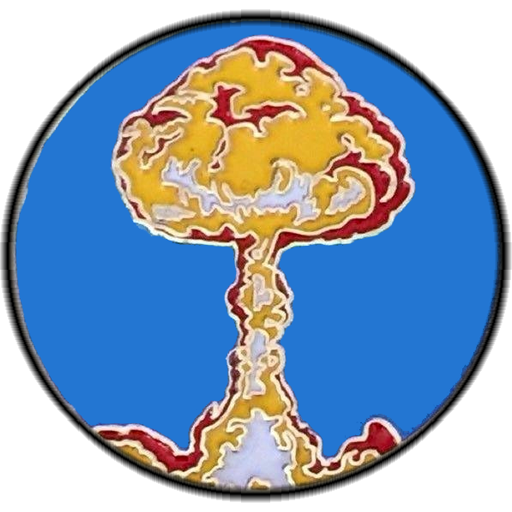Mk38
- Designer
- Lawrence Radiation Laboratory
- Type
- Implosion
- Dimension(s)
- 82.5″ x 32″
- Weight(s)
- ~3,080lbs
- Yield
- 4.5Mt
- Warhead
- W38, Mk4 Aeroshell – Atlas E & F (SM-65)
- Warhead
- W38, Mk4 Aeroshell – Titan I (SM-68A)
Designed by Lawrence Livermore National Laboratory4.1, weighing 3,080lbs, the warhead was 6′ 10.5″ long with a diameter of 2′ 8″3.1, it was deployed on the Atlas E/F2.1, and Titan I with the Mk4 re-entry body (RB).1.1 The fuzing and firing components were contained in a cylindrical space 34″ in diameter and 24″ long.9.3 The first production unit (FPU) was in May 19615.1 it remained in the stockpile until 1962 and eventually retiring in 1956.
Originally open to both Los Alamos Scientific Laboratory (LASL) and the University of California Radiation Laboratory (UCRL) in July 1955, on the 19th of January, 1956 the XW-38 was assigned to the UCRL.9.1
In March 1956, the design was expanded to include the Titan, Thor, and Jupiter ballistic missiles. In July, the Albuquerque Operations Office authorized full-scale development of the XW-38. In November, the Divisions of Military Application changes design of the XW-38 to a 3000lb warhead, to be provided on a low-priority basis as a follow-on to the Los Alamos designed XW-35.9.1
In March the designation of the XW-35-X1 is assigned to the high-yield XW-38 on May 13, 1959, an amendment to the military characteristics deletes the requirement for compatibility of the XW-38-X1 with the Thor and Jupiter missiles.9.2
With production authorization for the XW-38-X1 being authorized in November 1959, the FPU was in May of 1961, and its retirement in 1965.9.2
Utilized the “Robin” primary4.1
The warhead would be capable of becoming electronically armed within 5 seconds of receipt of the arming signal and remaining in this condition for at least 90 seconds, and would fire upon receipt of either air-burst or contact-burst signals. If, when armed, electrical energy was stored in the warhead awaiting the firing signal, a device would be incorporated to safely dissipate the electrical energy in the shortest time possible, not to exceed 10- minutes and not to interfere with the normal arming-firing sequence.9.4
With the heat shield installed, it had a diameter of 33.24″ and a weight of 3,309lbs9.5 the heat shield was constructed of fiberglass covered with oblique tape-wound fibrous quartz.9.6



















- Hansen, C. (1988). US Nuclear Weapons: The Secret History. Crown Publishers Inc. http://www.worldcat.org/oclc/16404602
- p.110 (PDF Page)
- Norris, R. S., & Cochran, T. B. (1994). United States Nuclear Tests July 1945 to 31 December 1992 (NWD 94-1; p. 74). Natural Resources Defense Council. https://fas.org/nuke/cochran/nuc_02019401a_121.pdf
- p.30 (PDF Page)
- Polmar, N., & Norris, R. S. (2009). The US Nuclear Arsenal: A History of Weapons and Delivery Systems Since 1945. Naval Institute Press. http://www.worldcat.org/oclc/690381240
- p.67 (PDF Page)
- Hansen, Chuck. (2001). Beware the Old Story. Bulletin of the Atomic Scientists, 57(1–6). https://www.tandfonline.com/toc/rbul20/57/1?nav=tocList
- p.133 (PDF Page)
- Norris, R. S., & Cochran, T. B. (1997). Nuclear Weapons Databook: US – USSR/Russian Strategic Offensive Nuclear Forces 1945-1996. Natural Resources Defense Council Inc. https://fas.org/nuke/norris/nuc_01009701a_181.pdf
- p.28 (PDF Page)
- Ogle, W. E. (1985). An Account of the Return to Nuclear Weapons Testing by the US After the Test moratorium 1958-1961 (NVO-291; p. 486). Department of Energy. https://www.osti.gov/opennet/servlets/purl/16156584.pdf
- p.106 (PDF Page)
- Cochran, T. B., Arkin, W. M., & Hoenig, M. M. (1984). Nuclear Weapons Databook Volume 1: U.S. Nuclear Forces and Capabilities. Ballinger Publishing Company.
- p.30 (PDF Page)
- p.131 (PDF Page)
- Weaponry Training Department Activities FY 1962. (1962).
- p.8 (PDF Page)
- Sandia National Laboratory Information Research Division 3434. (1968). History of the Mk38 Warhead (RS 3434/19). Los Alamos National Laboratory.
- p.4 (PDF Page)
- P.5 (PDF Page)
- p.8 (PDF Page)
- p.9 (PDF Page)
- p.13 (PDF Page)
- p.14 (PDF Page)
